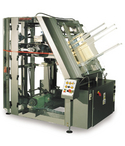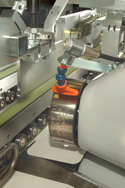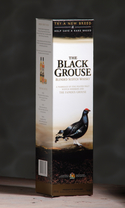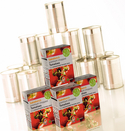Cartons lead the way
19 September 2008Packaging Today considers some new carton and carton-packing concepts
Cartons must play multiple roles in the packaging world. First and foremost, they should be rigid and adequately protect the product within. Secondly, they must embody good aesthetics and exemplify the product quality. Finally, it is important that the cartons are easily and efficiently filled on today’s carton-erecting machines. Of course, environmental considerations are also having an impact, and today’s cartons may incorporate recycled material or be designed to be lightweight.
Adding value to whisky
Edrington’s Black Grouse Scotch Whiskey was launched to the UK market on 8 June, following successful launches elsewhere in Europe and South Africa. The company specified that the packaging should have environmental characteristics, yet retain good aesthetics. ProCarton (the Association of European Cartonboard and Carton Manufacturers) recently published The Effect of Packaging on Brand Recognition. This claims that cartons assist with achieving brand recognition and increase the incidence of purchasing.
As all readers will be aware, environmental considerations are becoming increasingly important to consumers and governments alike. In its packaging brief, Edrington stated that the carton must be made from Forest Stewardship Council (FSC)-accredited board, indicating that the raw material was sourced from sustainable woodland. The carton design was achieved by printing five colours together with an all-over satin varnish, highlighting the Black Grouse illustration and brand text with a spot-gloss varnish. The carton also features gold foil blocking and detailed embossing. The cartons are produced at Chesapeake’s facility in East Kilbride, Scotland.
No room for complacency
Tetra Pak supplied a record 137 billion individual packages during 2007, helping leading food and beverage companies deliver over 69.5 billion litres of milk and juice. The company has undertaken further development of its packs, including Tetra Top, designed for high acid ambient distribution (HAAD) of still drinks, such as ice tea, fruit drinks and sports drinks without the chilled chain. Ranging in size from 200-1000ml, Tetra Pack launched the system in Spring 2008, claiming that Tetra Top can be used to store ambient still drinks for up to six months without the need for preservatives. The company has designed the pack so that it is easy to open, reclose and pour.
Another development is the Tetra Top Eifel O38, which provides one-step opening and incorporates tamper-evidence in the cap. This has a 38mm opening and is easily resealed, being ideal for chilled dairy and juice products. The manufacturer states that the rigid plastic in the cap makes the pack more efficient to transport as it improves its stackability. This also eliminates the requirement for a wrap-around box.
In 2007, Tetra Pak launched Tetra Gemina Aseptic, which is a roll-fed gable-top package providing full aseptic performance for milk and dairy customers. The company claims that these cartons combine the convenience, safety and nutritional benefits of aseptic packaging with functionality. The package is available in 500, 750 and 1000ml sizes. It is currently being used by Fruité of France, Sady Pridonia of Russia and Coca-Cola brands in Kazakhstan, amongst others.
Tetra Pak has also augmented its Tetra Recart portfolio of carton-based retortable food packaging with the 340ml and 500ml pack sizes. The company designed the cartons specifically for shelf-stable food products that are traditionally packed in glass jars and tins. It claims that the combination of packaging material, form fill and sealing technique enables fresh foods to be sterilised inside a carton package, maintaining shelf-stability for up to two years. Tetra Pak considers that the square shape of the package increases shelf space by up to 40 per cent, presenting an attractive in-store ‘product wall’ to the shopper. In November 2007, Tetra Recart became the first Tetra Pak carton to be FSC-accredited.
Investments in carton manufacture
Carton manufacturer Boxes Prestige, which has sites in the UK and Poland located in Northampton and Lublin, respectively, has recently undertaken some investment. This includes purchasing two of the seven-unit Roland 700 B1-format presses, one of which is being installed in each facility. The investment follows a 50 per cent increase in manufacturing capability at Boxes Prestige Poland.
Both presses include dedicated coaters and UV drying systems. Boxes Prestige considers that this will reduce downtime between print runs, ensure colour consistency and provide additional production flexibility. The presses will be alcohol-free, thereby reducing the company’s environmental impact. At its UK operation, Boxes Prestige has also installed a Bobst Alpina Folder-Gluer 2 and an XM Easybender. Boxes Prestige states that the Folder-Gluer will offer faster running speeds and make-ready times, providing improved flexibility and control. The company has also commented that the XM Easybender will cut the diemaking time by up to 75 per cent.
Boxes Prestige has also restructured its reprographics department so it can incorporate wet-proofing, colour-managed digital proofing and CTP trade output. The new facility is designed to ensure the maintenance of brand and colour consistency.
Braille becomes a necessity
Pharmaceutical carton manufacturer, Medica Packaging (part of the Benson Group), has reported that it is the first UK plant to install Bobst’s AccuBraille system for the Braille embossing of pharmaceutical cartons. Mark Kerridge, Managing Director, Benson Group, commented: “The main benefits to us of the AccuBraille unit are that it will further shorten the supply time to get cartons to our customers, making it easier to maintain the quality of our Braille embossing.” The company believes this system to be more efficient than the conventional die-cutting technique. This development has come in advance of the EU directive stating that all pharmaceutical packaging for EU use must incorporate Braille information by 2010.
Efficient carton erecting
Unilever has placed orders for four of Kliklok’s ECT500 carton erectors for its Lipton’s tea plant in Jebel Ali, Dubai. Kliklok has already installed this glue-form machine at the Lipton’s plants in Iran and Karachi, Pakistan. The ECT500 is capable of handling a range of carton tray designs formed from a single flat blank, including typical four-corner styles and complex hexagonal, octagonal, and other unusually-shaped packages. The ECT500 incorporates a four-station rotary turret design used to realise carton feeding, glue application, carton forming, and finished carton ‘strip-off’ at progressive turret positions. Glue is applied either by a nozzle-jet system or an open pot ‘dauber’ style, depending on the customer’s preference.
Creativity on the whisky front
Van Genechten Packaging (VGP) has developed a range of packaging solutions for the FMCG and Luxury Brands markets. The Group has received awards from the European Carton Makers’ Association (ECMA) and in the Pentawards and Luxe Pack design awards. The company claims to always forge a close relationship between its packaging development personnel and its customers’ marketing and development organisations. This serves to establish a linkage between the concept and those involved in its realisation.
When the Glenmorangie single malt Scotch whisky brand management group decided to undertake the transition from a tube to a folding carton, VGP was selected as its partner. Glenmorangie is part of the LVMH Group, to which VGP is a long-standing supplier of cartons for Moët & Chandon Champagne. VGP is able to undertake numerous processes in-house, including cross-board lamination, windowing, hot-foiling, embossing and in-line matt and high-gloss varnish combinations. In addition to board cartons, the company manufactures cartons from PET, PVC, PP and microflute.
Concluding remarks
It may appear that innovations in the carton world have reached a plateau. However, the major players are always looking to develop cartons that impart a sense of added value and have sturdy environmental characteristics. Furthermore, machinery manufacturers across the world are seeking to develop carton erection machines that are more efficient and can be easily reconfigured to meet the needs of a changing market.
Medica Packaging has installed Bobst's AccuBraille system for the Braille embossing of pharmaceutical cartons Easy reproduction of Braille Boxes Prestige has installed seven-unit Roland 700 B1-format presses at its plants in the UK and Poland Investment for efficiency The new carton for Black Grouse whisky incorporates special finishes, yet has strong environmental credentials No need to grouse about the environment Unilever has ordered four of Kliklok's ECT500 carton erectors for its Lipton's tea plant in Jebel Ali, Dubai Unilever in Dubai The Tetra Pak Recart carton has been designed specifically for shelf-stable food products that are traditionally packed in glass jars and tins Replacing tins and jars






